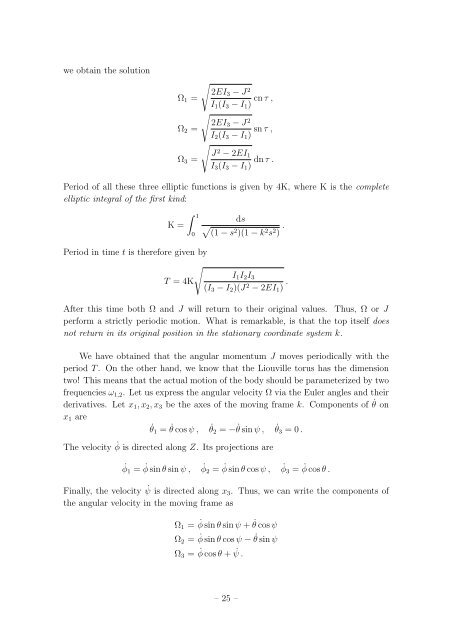Student Seminar: Classical and Quantum Integrable Systems
Student Seminar: Classical and Quantum Integrable Systems
Student Seminar: Classical and Quantum Integrable Systems
Create successful ePaper yourself
Turn your PDF publications into a flip-book with our unique Google optimized e-Paper software.
we obtain the solution<br />
Ω 1 =<br />
Ω 2 =<br />
Ω 3 =<br />
√<br />
2EI 3 − J 2<br />
I 1 (I 3 − I 1 ) cn τ ,<br />
√<br />
2EI 3 − J 2<br />
I 2 (I 3 − I 1 ) sn τ ,<br />
√<br />
J 2 − 2EI 1<br />
I 3 (I 3 − I 1 ) dn τ .<br />
Period of all these three elliptic functions is given by 4K, where K is the complete<br />
elliptic integral of the first kind:<br />
K =<br />
∫ 1<br />
0<br />
ds<br />
√<br />
(1 − s2 )(1 − k 2 s 2 ) .<br />
Period in time t is therefore given by<br />
√<br />
I 1 I 2 I 3<br />
T = 4K<br />
(I 3 − I 2 )(J 2 − 2EI 1 ) .<br />
After this time both Ω <strong>and</strong> J will return to their original values. Thus, Ω or J<br />
perform a strictly periodic motion. What is remarkable, is that the top itself does<br />
not return in its original position in the stationary coordinate system k.<br />
We have obtained that the angular momentum J moves periodically with the<br />
period T . On the other h<strong>and</strong>, we know that the Liouville torus has the dimension<br />
two! This means that the actual motion of the body should be parameterized by two<br />
frequencies ω 1,2 . Let us express the angular velocity Ω via the Euler angles <strong>and</strong> their<br />
derivatives. Let x 1 , x 2 , x 3 be the axes of the moving frame k. Components of ˙θ on<br />
x 1 are<br />
˙θ 1 = ˙θ cos ψ , ˙θ2 = − ˙θ sin ψ , ˙θ3 = 0 .<br />
The velocity ˙φ is directed along Z. Its projections are<br />
˙φ 1 = ˙φ sin θ sin ψ , ˙φ2 = ˙φ sin θ cos ψ , ˙φ3 = ˙φ cos θ .<br />
Finally, the velocity ˙ψ is directed along x 3 . Thus, we can write the components of<br />
the angular velocity in the moving frame as<br />
Ω 1 = ˙φ sin θ sin ψ + ˙θ cos ψ<br />
Ω 2 = ˙φ sin θ cos ψ − ˙θ sin ψ<br />
Ω 3 = ˙φ cos θ + ˙ψ .<br />
– 25 –

















